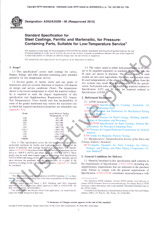We need your consent to use the individual data so that you can see information about your interests, among other things. Click "OK" to give your consent.
ASTM E1450-16
Standard Test Method for Tension Testing of Structural Alloys in Liquid Helium
Translate name
STANDARD published on 15.11.2016
The information about the standard:
Designation standards: ASTM E1450-16
Note: WITHDRAWN
Publication date standards: 15.11.2016
SKU: NS-676167
The number of pages: 9
Approximate weight : 27 g (0.06 lbs)
Country: American technical standard
Category: Technical standards ASTM
The category - similar standards:
Annotation of standard text ASTM E1450-16 :
Keywords:
adiabatic heating, cryogenic properties (of materials), discontinuous yielding, liquid helium, low temperature tests, mechanical properties (of materials), tensile cryostats, tensile properties, tension test ,, ICS Number Code 77.040.10 (Mechanical testing of metals)
Additional information
| Significance and Use | ||||||||||||||||
|
4.1 Tension tests provide information on the strength and ductility of materials under uniaxial tensile stresses. This information may be useful for alloy development, comparison and selection of materials, and quality control. Under certain circumstances, the information may also be useful for design. 4.2 The force-time and force-extension records for some alloys tested in liquid helium using displacement control are often serrated 4.3 A constant specimen temperature cannot be maintained at all times during tests in liquid helium. The specimen temperature at local regions in the reduced section rises temporarily above 4 K during each discontinuous yielding event (see Fig. 2), owing to adiabatic heating. The number of events and the magnitude of the associated drops in magnitude of force are a function of the material composition and other factors such as specimen size and test speed. Typically, altering the mechanical test variables can modify but not eliminate the discontinuous yielding (2-4). Therefore, tensile property measurements of alloys in liquid helium (especially tensile strength, elongation, and reduction of area) lack the usual significance of property measurements at room temperature where deformation is more nearly isothermal and discontinuous yielding typically does not occur. 4.4 The stress-strain response of a material tested in liquid helium depends on whether force control or displacement control is used 1.1 This test method describes procedures for the tension testing of structural alloys in liquid helium. The format is similar to that of other ASTM tension test standards, but the contents include modifications for cryogenic testing which requires special apparatus, smaller specimens, and concern for serrated yielding, adiabatic heating, and strain-rate effects. 1.2 To conduct a tension test by this standard, the specimen in a tensile cryostat is fully submerged in normal liquid helium (He I) and tested using crosshead displacement control at a nominal strain rate of 10−3 mm/mm/s or less. Tests using force control or high strain rates are not considered. 1.3 This standard specifies methods for the measurement of yield strength, tensile strength, elongation, and reduction of area. The determination of the Young’s modulus is treated in Test Method E111. Note 1: The boiling point of normal liquid helium (He I) at
sea level is 4.2 K (−269°C or −452.1°F or 7.6°R). It decreases with
geographic elevation and is 4.0 K (−269.2°C or −452.5°F or 7.2°R)
at the National Institute of Standards and Technology in Colorado,
1677 m (5500 ft) above sea level. In this standard the temperature
is designated 4 K.
1.4 Values stated in SI units are treated as primary. Values stated in U.S. customary units are treated as secondary. 1.5 This standard does not purport to address all of the safety concerns, if any, associated with its use. It is the responsibility of the user of this standard to establish appropriate safety and health practices and determine the applicability of regulatory limitations prior to use. See Section 5. |
||||||||||||||||
| 2. Referenced Documents | ||||||||||||||||
|
We recommend:
Technical standards updating
Do you want to make sure you use only the valid technical standards?
We can offer you a solution which will provide you a monthly overview concerning the updating of standards which you use.
Would you like to know more? Look at this page.




 Cookies
Cookies
